Stirling Henry Ltd. – Textile Manufacturers

The Stirling Henry administration building in Homebush West, c.1950 by Max Dupain. Courtesy State Library of NSW
Residents of Homebush West may be familiar with the Harvey Norman head office building at A1 Richmond Road. Built in 1940, this was once the head office of another large business, the textile manufacturers, Stirling Henry Ltd. The company was established in 1924 by Robert Stirling Henry. Initially an importer of knitted garments, in 1926 Stirling Henry Ltd opened a small factory in inner Sydney producing cotton garments, after the introduction of government tariffs made it unprofitable to continue importing finished goods.[1] The business expanded even during the Great Depression. Soon, a knitting plant was added and by 1936 most operations had moved to Flemington (Homebush West) with the addition of spinning and weaving mills. Machinery was purchased in England, shipped, installed and quickly put to use. The company became self-sufficient for the production of knitted garments from the raw cotton onwards. Two shifts a day employed 100 men and women per shift. Cotton yarn production used 5000 spindles to produce 10,000 yards during each shift.[2]
At its peak, Stirling Henry occupied 27 acres of land at Flemington.[3]
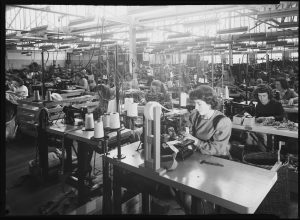
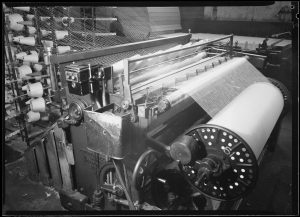
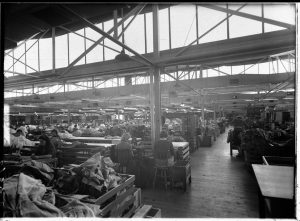
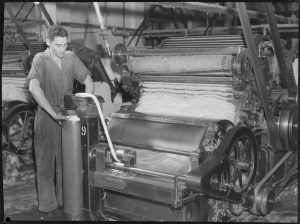
Stirling Henry, late 1940s. Courtesy State Library of NSW and NSW State Archives & Records
During September 1937 there was a fire at the factory with damage estimated at £15,000.[4][5][6] Local schoolchildren crowded into the grounds to watch and had to be removed. Two firemen were injured.[7]
In 1940 the company reported a profit of more than £20,000.[8] By this time all operations had transferred to Flemington. Patriotically, employees raised enough money to donate an ambulance to the army in early 1941.[9] In August and September 1941 textile mill workers went on strike, seeking higher wages for their valuable wartime work. All 800 Stirling Henry workers were on strike in early September.[10]
Stirling Henry’s wartime production included the supply of cotton and underwear to the armies, navies and air forces of both Australia and the USA as well as shorts, trousers, overalls, drill cloth and gauze for bandages. When Japan entered the war, the factory received 4000 shirts and 4000 trousers on a Saturday afternoon and dyed them jungle green over the weekend, ready to be shipped on Monday. The factory was able to maintain three shifts, working 24 hours per day. At times, war service orders accounted for 95% of all production.
Wartime was eventful on the home front too. On 29 September 1943 Homebush was badly hit by a hailstorm. Extensive damage and flooding to the factory and surrounding areas resulted in the male workers carrying the female employees on their backs through the floodwaters.[11]
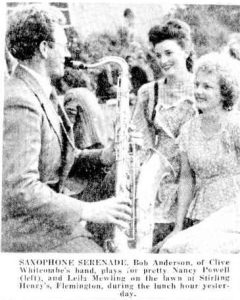
The Sun 23 May 1946 p.10
With war over, in January 1946 Stirling Henry offered jobs to 150 ex-servicemen and women.[12] The company went to great lengths to attract new female workers by offering attractive conditions and perks, including a cafeteria, showers, a nurse and a swing band at lunchtime once a week.[13] But by May of that year 400 women were still required[14] and production levels remained lower than the demand for new clothing, even though the rationing of clothing did not end until 1948.
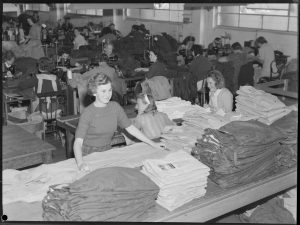
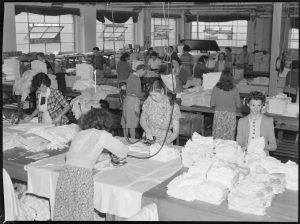
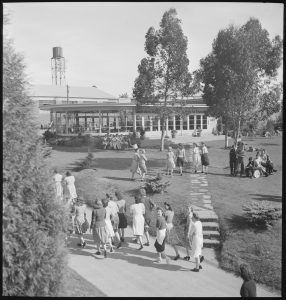
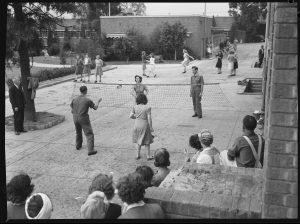
Stirling Henry by Max Dupain, late 1940s and early 1950s. Courtesy State Library of NSW
On 19 November 1946 two carriages of a train jumped the points near Rookwood Cemetery and derailed. Of the seven people hospitalised, five were employees of Stirling Henry who had dragged themselves to work before being sent for medical treatment.[15][16]
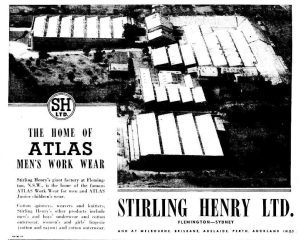
Smith’s Weekly 31 December 1949 p.27
By 1948 there were plans for new buildings at Flemington to accommodate more than 1000 employees.[17] In 1952, Managing Director, Hartley Feather complained to the government about large orders for khaki cloth being sent to Japan when Stirling Henry and other textile firms had supplied millions of yards of khaki cloth during the war.[18]
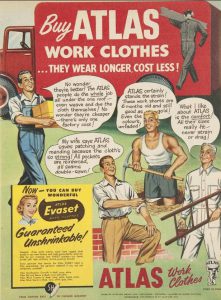
Australian Women’s Weekly 2 February 1955 p.43
Stirling Henry Ltd operated in Homebush West until the late 1960s when the premises were purchased by St. Regis/ACI who manufactured laminates for wine casks, later becoming AstraPak Ltd.
Today the spacious grounds and swing band are long gone but the main administrative building remains in Homebush West.
Stirling Henry Ltd features in the Minding Our Business: Strathfield’s Industrial Heritage exhibition currently on display in the Ironbark Gallery of Strathfield Library. Please see Ironbark Gallery – Strathfield Council (nsw.gov.au) for further details. You can register for the talk on 31 July at: Talk on Industrial Heritage of Strathfield Exhibition Tickets, Sun 31/07/2022 at 12:30 pm | Eventbrite
By J.J. MacRitchie
References
[1] Stirling Henry Ltd., 1924-1947: a Story of Progress p.3[2] Daily Telegraph 31 March 1936 p.17 https://trove.nla.gov.au/newspaper/article/246732940
[3] Stirling Henry Ltd., 1924-1947: a story of progress p.3
[4] The Sun 29 September 1937 p.1 https://trove.nla.gov.au/newspaper/article/229453230
[5] The Cumberland Argus and Fruitgrowers Advocate 30 September 1937 p.5
https://trove.nla.gov.au/newspaper/article/106166526
[6] Sydney Morning Herald 30 September 1937 p.11 https://trove.nla.gov.au/newspaper/article/17401546
[7] The Labor Daily 30 September 1937 p.7 https://trove.nla.gov.au/newspaper/article/237755375
[8] Sydney Morning Herald 21 August 1940 p.9 https://trove.nla.gov.au/newspaper/article/17676971
[9] The Sun 11 March 1941 p.2 https://trove.nla.gov.au/newspaper/article/231207568
[10] The Sun 4 September 1941 p.3 https://trove.nla.gov.au/newspaper/article/231626039
[11] The Daily Telegraph 30 September 1943 p.7 https://trove.nla.gov.au/newspaper/article/247790065
[12] The Daily Telegraph 10 January 1946 p.7 https://trove.nla.gov.au/newspaper/article/248471848
[13] The Daily Telegraph 21 May 1946 p.5 https://trove.nla.gov.au/newspaper/article/248507994
[14] The Newcastle Sun 22 May 1946 p.1 https://trove.nla.gov.au/newspaper/article/157704475
[15] The Sun 19 November 1946 p.1 https://trove.nla.gov.au/newspaper/article/229540007
[16] The Daily Telegraph 20 November 1946 p.7 https://trove.nla.gov.au/newspaper/article/248363539
[17] The Sun 29 October 1948 p.12 https://trove.nla.gov.au/newspaper/article/231148133
[18] The Cumberland Argus 26 March 1952 p.1 https://trove.nla.gov.au/newspaper/article/132148179

2 Comments. Leave new
Awesome, great article
Thanks for the feedback.